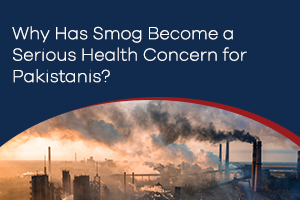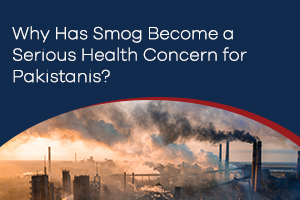Why Has Smog Become a Serious Health Concern for Pakistanis?

The current air quality index for Lahore shows that the air is unhealthy because of severe air pollution. And as winter is coming, so is smog in Lahore.
Around 7 million people per year die from air pollution worldwide, according to the World Health Organization (WHO), 4.2 million of which are due to exposure to ambient air pollution. In addition, 9 out of 10 people breathe air that exceeds WHO guideline limits for pollutants, with low-and middle-income countries suffering the most, including Pakistan.
Do you know that Lahore ranked first in the list of most polluted cities in the world in 2021 with an air pollution level of 108 µg/m3? Even the present situation of Lahore’s air is alarming as its PM2.5 concentration is 14.6 times the WHO annual air quality guideline value.
One of the major reasons is that it gets surrounded by a thick layer of smog in the winter season. Furthermore, the city’s air quality has worsened as a result of increasing urbanization and industrialization.
What is Smog?
Smog, often known as smoke fog, is a type of severe air pollution. The term “smog,” a combination of the words “smoke” and “fog,” was first used to describe smoky fog in the early 20th century because of its opacity and odour.
What is Smog Composed of?
Smog is a form of air pollution that is a combination of numerous toxic effluents from industrial and residential activities. These activities occur both naturally and artificially as everything is just tossed into the atmosphere without being processed. It leads to air pollution and harm to the environment as well as every existing living being on the planet.
The main components of the smog are as follows:
- Tropospheric Ozone
- Sulphur Oxides
- Smoke
- Nitrogen Oxides
- Carbon Monoxide
- Volatile Organic Compounds (VOCs)
- Pollen
- Dust
- Ammonia Gas
- Other Chemicals
These elements, or pollutants, that make up smog are chemically highly reactive and extremely dangerous to both people and various animals.
Smog Formation
There are two types of smog:
- Sulfurous Smog
- Photochemical Smog
The smog we suffer from is photochemical smog. And it forms when sunlight combines with nitrogen oxides and at least one volatile organic compound (VOC) in the atmosphere.
Causes of Smog in Lahore, Pakistan
In Pakistan, Lahore is the city that has been affected the most by smog in the country over the last few years. The city is overpopulated and it is an industrialized region with a huge traffic problem.
So, the reasons for smog in Lahore are vehicle emissions, industrial pollution, fossil-fuel-fired power stations, waste-burning, and coal burned by thousands of brick kilns spread over the region. These are all contributors to the problem.
These emissions result in:
- Nitrogen oxides come from automobiles, coal power stations, and factories.
- VOCs are emitted by gasoline, paints, and a variety of cleaning solutions.
So, when sunlight strikes these compounds, they produce airborne particles and ground-level ozone, causing smog in Punjab. It leads to injurious health issues and causes detrimental effects on the environment.
Dangerous Effects of Smog
The effects of air pollution on living organisms will not only harm human and animal health but will also affect the entire environment. Various geographical conditions, global temperature changes, and environmental variations all have an impact on human health and the environment, including animal life.
1. Human Health Hazards Caused by Smog
A lot of factors influence the impact of smog on your health and general well-being. However, let us look at the people who are most vulnerable to the hazardous effects of smog:
- Individuals with heart disease, coronary artery disease, or congestive heart failure
- Individuals with lung diseases
- Pregnant women
- Outdoor workers
- Older adults and the elderly
- Children under the age of 14
- Athletes who work out vigorously outdoors
Smog in Lahore causes the air index to deteriorate, which leads to health issues for the residents. We have described the diseases in people caused by smog in Punjab.
10 Diseases Caused by Smog
Air pollution causes the following diseases in human beings:
1. Asthma
Asthma is one of the most frequent disorders brought on by polluted air. It constricts and swells the airways and creates excess mucus, making breathing difficult. Asthma is a chronic air pollution disease that leads to severe shortness of breath, making even daily, routine activities difficult.
2. Bronchitis
Bronchitis is caused by prolonged exposure to increased levels of air pollution, particularly a high percentage of sulfur dioxide and nitrogen dioxide in the air, which causes bronchitis. It is an acute inflammation of the lining of the bronchial tubes that transport air to and from the lungs. Bronchitis is characterized by shortness of breath and prolonged, intense coughing with thick mucus.
3. Lung Cancer
Smoking, exposure to cigarette smoke, a family history, or prolonged exposure to toxic air pollution, mainly smog in Lahore, are the main causes of lung or pulmonary cancer. Common symptoms include severe chest pain, coughing, wheezing, hoarseness, and weight loss.
4. Chronic Obstructive Pulmonary Disease (COPD)
COPD is a chronic disorder that causes obstruction in the airways of the lungs, causing difficulty breathing, wheezing, and a chronic cough. COPD, one of the most frequent diseases caused by air pollution, causes irreversible damage to the lungs and can progress to severe symptoms such as bronchitis and emphysema.
5. Birth Defects
Prenatal and neonatal exposure to harmful air can result in air pollution disorders and birth abnormalities. Premature birth, low birth weight, persistent and chronic colds and coughs, various allergies, and even neurological abnormalities are all serious concerns. As a result, pregnant women are advised to ensure a steady supply of clean, fresh, and unpolluted air.
6. Immune System Disorders
Prenatal and neonatal exposure to polluted air can also weaken immunity, putting the baby vulnerable to a variety of health problems. Diseases caused by smog in Punjab in newborns can lead to serious health problems later in life.
7. Cardiovascular Issues
Prolonged exposure to particulate matter pollution and toxic chemicals can impair blood vessel function and promote arterial calcification. The severity of heart disease caused by air pollution is determined by the type of pollutant and the duration of exposure.
8. Pneumonia
Pneumonia is a serious, occasionally fatal disease that affects both children and the elderly and is mostly brought on by bacteria, fungi, and parasites in polluted air. It is a lung infection that causes pus to fill the air sacs in one or both lungs, causing difficulty breathing, phlegm-filled coughs, chills, and fever.
9. Leukemia
Smog in Lahore is also causing leukemia in the residents of the city. Leukemia is a cancer of the blood and bone marrow that causes bruising, joint and bone pain, bleeding, weight loss, fever, and other symptoms. Exposure to radiation and harmful pollutants in the air, family history, smoking, and other factors are major causes of leukemia.
10. Early Deaths
Toxic chemicals in the air, particularly those emitted by factories, can trigger severe reactions in some individuals, resulting in asphyxiation and death. The number of young individuals dying as a result of air pollution-related illnesses is on the rise.
Plants and animals play essential roles in the natural environment. Humans use them for food, business, and other purposes. Smog also affects them dangerously.
2. Effects of Smog on Animals
The effects of smog in Lahore make it hard for animals to adapt to or survive in such dangerous conditions. Air pollution can kill or sicken various animal species.
3. Effects of Smog on Plants
Smog in Punjab restricts plant development and can affect crops, trees, and vegetation. It impairs their ability to fight infections, making them more prone to sickness.
4. Environmental Effects of Smog
Air pollution, in addition to endangering human health, can have a wide range of environmental implications:
- The particles in the smog cause visibility impairment
- Acidification of lakes and streams
- Modifying the nutritional balance in vast river basins and coastal waters
- Decreasing soil nutrients
- Endangering vulnerable ecosystems and agricultural crops
- Impacting habitat diversity
- Enhancing the impacts of acid rain
Precautionary Measures Against Smog
The smog in Punjab is a serious condition and you need to be very careful if you do not want to get sick as smog season is coming. So, we have described some of the precautionary measures for you that you can follow when smog hits Lahore.
- Wear a mask
- Run an air-purifier
- Avoid being outside near high-traffic areas to reduce your exposure.
- Take rest breaks in the shade and drink plenty of water when you’re outside.
- Avoid doing intense outdoor work.
- Avoid driving and smoking to reduce your carbon output.
- If you must drive, drive slowly and use headlights, fog lights, blinkers, and hazards at all times.
- Close windows and other air inlets when indoors.
- If you have asthma or chronic obstructive pulmonary disease, have your inhaler with you at all times. Keep your doctor’s number handy in case your illness worsens.
- It is important to note that pollution affects everyone differently, and some people are more vulnerable to its detrimental effects.
- On smoggy days, persons with asthma, children, and the elderly should take extra precautions.
- Bicyclists must cover their faces and wear glasses to protect their eyes.
- Drink plenty of water and constantly wash your hands.
- Avoid crowded areas where you can be caught in traffic if you have breathing problems and need to travel on foggy days.
- Road junctions can be a hive of exhaust pollutants, so keep your windows closed.
- Avoid airports, seaports, and industrial locations as well.
- If you are walking or cycling to work, choose a route that avoids densely populated or crowded areas.
- Reduce your own emissions as much as possible. Avoid needless car trips in cities, and don’t leave your engine running for long periods of time outside your house on cold days or when stuck in traffic.
Due to these harmful emissions, notably transboundary air pollution, air quality is declining day by day in cities. As a result, Lahore, the provincial capital, is one of the most polluted cities in the world, and the smog layer will thicken in the upcoming days.
Therefore, in order to reduce smog in Lahore, immediate action must be taken to address this issue. Both public and private institutions should adopt policies to reduce pollution from sources, particularly the emissions of particulate matter and nitrogen oxides.
